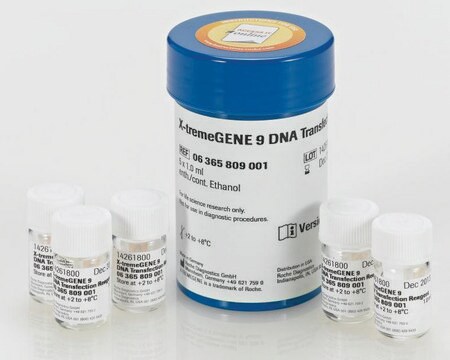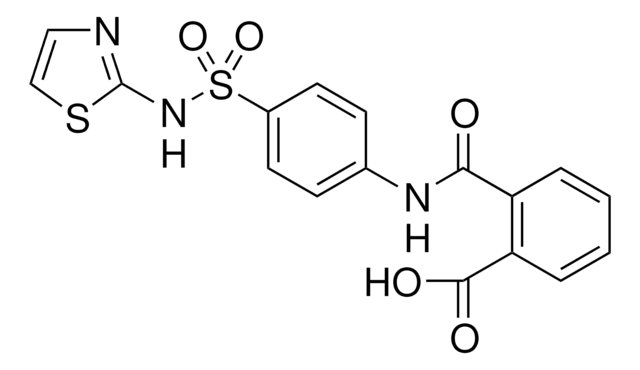XTGHP-RO
Roche
Réactif de transfection d'ADN X-tremeGENE™ HP
High-performance polymer reagent for transfecting many cell lines
About This Item
Produits recommandés
Qualité
for molecular biology
Niveau de qualité
Forme
liquid (aqueous solution)
Utilisation
mL (suitable for 165 transfections)
Conditionnement
pkg of 0.4 mL (06366244001)
pkg of 1.0 mL (06366236001)
pkg of 5 × 1 mL (06366546001)
Fabricant/nom de marque
Roche
Technique(s)
transfection: suitable
Température de stockage
−20°C
Description générale
Caractéristiques et avantages
- Tirez parti d'un réactif non liposomal facile à utiliser qui ne contient aucun constituant d'origine animale, est stable à température ambiante, est filtré sur une membrane de 0,2 μm de dimension de pore et est actif dans les milieux à base de sérum.
- Atteignez de nouveaux niveaux d'efficacité de transfection dans les cellules primaires et les lignées de cellules tumorales qui sont mal transfectées par d'autres réactifs.
- Obtenez des données valides sur le plan physiologique grâce à un réactif de faible cytotoxicité.
- Augmentez vos cadences expérimentales et évaluez vos cibles à l'aide d'un protocole simple et cohérent.
Qualité
Forme physique
Autres remarques
Informations légales
Produit(s) apparenté(s)
Mention d'avertissement
Danger
Mentions de danger
Conseils de prudence
Classification des risques
Eye Irrit. 2 - Flam. Liq. 2
Code de la classe de stockage
3 - Flammable liquids
Classe de danger pour l'eau (WGK)
WGK 1
Point d'éclair (°F)
334.4 °F
Point d'éclair (°C)
168 °C
Certificats d'analyse (COA)
Recherchez un Certificats d'analyse (COA) en saisissant le numéro de lot du produit. Les numéros de lot figurent sur l'étiquette du produit après les mots "Lot" ou "Batch".
Déjà en possession de ce produit ?
Retrouvez la documentation relative aux produits que vous avez récemment achetés dans la Bibliothèque de documents.
Les clients ont également consulté
Articles
Automation is used for many applications to reduce variation caused by manual handling and to obtain reproducible results in high-throughput assays. High-throughput applications, such as knockdown studies or target screenings, often include cell transfection.
Small inhibitory RNAs (siRNAs) have become the focus of interest in many laboratories. For the first time, these molecules offer an easy way to knock down the expression of selected genes in mammalian cells without having to resort to classical gene knockout techniques.
Transfection is the introduction of DNA, RNA, or proteins into eukaryotic cells and is used in research to study and modulate gene expression. Thus, transfection techniques and protocols serve as an analytical tool that facilitates the characterization of genetic functions, protein synthesis, cell growth and development.
This brief webinar provides an overview of what transfection is and the methods that are used to introduce DNA or RNA into eukaryotic cells.
Protocoles
Lentiviruses represent a powerful tool in research applications to transduce a wide range of cell types.
Cell preparation for transfection Plate cells approx. 24 hours before transfection making sure cells are at optimal concentration (70 – 90 % confluency).
Transient co-transfection of plasmids is a method that is commonly employed for cellular protein-protein interaction studies, transcription factor studies, and gene knockdown studies using shRNA encoding plasmids.
Protocols for Transfecting Common Cell Lines with X-tremeGENE™ Transfection Reagents
Contenu apparenté
Browse our convenient transfection reagent selection guide to match the best reagent for your specific cell line and application needs.
Notre équipe de scientifiques dispose d'une expérience dans tous les secteurs de la recherche, notamment en sciences de la vie, science des matériaux, synthèse chimique, chromatographie, analyse et dans de nombreux autres domaines..
Contacter notre Service technique













